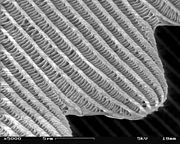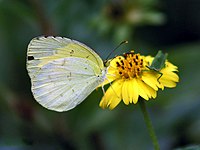Lepidoptera
| Lepidoptera | |
|---|---|

| |
| Peacock butterfly (Aglais io) | |
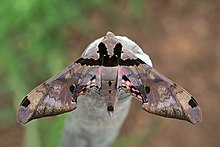
| |
sphinx moth
| |
| Scientific classification | |
| Domain: | Eukaryota |
| Kingdom: | Animalia |
| Phylum: | Arthropoda |
| Class: | Insecta |
| (unranked): | Amphiesmenoptera |
| Order: | Lepidoptera Linnaeus, 1758 |
| Suborders | |
|
Aglossata Glossata Heterobathmiina Rhopalocera Zeugloptera
| |
Lepidoptera (
Lepidopteran species are characterized by more than three derived features. The most apparent is the presence of
Lepidopterans first appeared in fossil record in the
Butterflies and moths are mostly
Etymology
The term Lepidoptera was used in 1746 by
The origins of the common names "butterfly" and "moth" are varied and often obscure. The
The etymological origins of the word "caterpillar", the larval form of butterflies and moths, are from the early 16th century, from Middle English catirpel, catirpeller, probably an alteration of Old North French catepelose (from Latin cattus, "cat" + pilosus, "hairy").[14]
Distribution and diversity
The Lepidoptera are among the most successful groups of insects. They are found on all continents, except Antarctica, and inhabit all terrestrial habitats ranging from desert to rainforest, from lowland grasslands to mountain plateaus, but almost always associated with higher plants, especially angiosperms (flowering plants).[15] Among the most northern dwelling species of butterflies and moths is the Arctic Apollo (Parnassius arcticus), which is found in the Arctic Circle in northeastern Yakutia, at an altitude of 1,500 metres (4,900 ft) above sea level.[16] In the Himalayas, various Apollo species such as Parnassius epaphus have been recorded to occur up to an altitude of 6,000 metres (20,000 ft) above sea level.[17]: 221
Some lepidopteran species exhibit
As of 2007, there were roughly 174,250 lepidopteran species described, with butterflies and skippers estimated to comprise around 17,950, and moths making up the rest.[1][20] The vast majority of Lepidoptera are to be found in the tropics, but substantial diversity exists on most continents. North America has over 700 species of butterflies and over 11,000 species of moths,[21][22] while about 400 species of butterflies and 14,000 species of moths are reported from Australia.[23] The diversity of Lepidoptera in each faunal region has been estimated by John Heppner in 1991 based partly on actual counts from the literature, partly on the card indices in the Natural History Museum (London) and the National Museum of Natural History (Washington), and partly on estimates:[5]
| Palearctic | Nearctic | Neotropic | Afrotropic | Indo-Australian (comprising Indomalayan, Australasian, and Oceanian realms) | |
|---|---|---|---|---|---|
| Estimated number of species | 22,465 | 11,532 | 44,791 | 20,491 | 47,287 |
External morphology
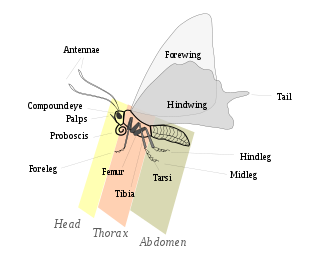
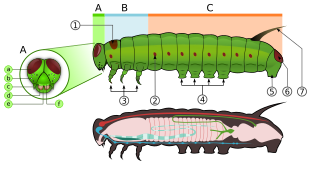
Lepidoptera are morphologically distinguished from other orders principally by the presence of
Head
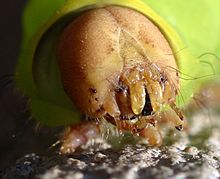
The head is where many sensing organs and the mouth parts are found. Like the adult, the larva also has a toughened, or
The
The larvae, called
Thorax
The thorax is made of three fused segments, the prothorax, mesothorax, and metathorax, each with a pair of legs. The first segment contains the first pair of legs. In some males of the butterfly family Nymphalidae, the forelegs are greatly reduced and are not used for walking or perching.[26]: 586 The three pairs of legs are covered with scales. Lepidoptera also have olfactory organs on their feet, which aid the butterfly in "tasting" or "smelling" out its food.[28] In the larval form there are 3 pairs of true legs, with up to 11 pairs of abdominal legs (usually eight) and hooklets, called apical crochets.[15]
The two pairs of wings are found on the middle and third segments, or mesothorax and metathorax, respectively. In the more recent genera, the wings of the second segment are much more pronounced, although some more primitive forms have similarly sized wings of both segments. The wings are covered in scales arranged like shingles, which form an extraordinary variety of colors and patterns. The mesothorax has more powerful muscles to propel the moth or butterfly through the air, with the wing of this segment (forewing) having a stronger vein structure.[26]: 560 The largest superfamily, the Noctuoidea, has their wings modified to act as tympanal or hearing organs.[29]
The caterpillar has an elongated, soft body that may have hair-like or other projections, three pairs of true legs, with none to 11 pairs of abdominal legs (usually eight) and hooklets, called apical crochets.[15] The thorax usually has a pair of legs on each segment. The thorax is also lined with many spiracles on both the mesothorax and metathorax, except for a few aquatic species, which instead have a form of gills.[26]: 563
Abdomen

The abdomen, which is less sclerotized than the thorax, consists of 10 segments with membranes in between, allowing for articulated movement. The sternum, on the first segment, is small in some families and is completely absent in others. The last two or three segments form the external parts of the species' sex organs. The genitalia of Lepidoptera are highly varied and are often the only means of differentiating between species. Male genitals include a valva, which is usually large, as it is used to grasp the female during mating. Female genitalia include three distinct sections.
The females of basal moths have only one sex organ, which is used for copulation and as an ovipositor, or egg-laying organ. About 98% of moth species have a separate organ for mating, and an external duct that carries the sperm from the male.[26]: 561
The abdomen of the caterpillar has four pairs of prolegs, normally located on the third to sixth segments of the abdomen, and a separate pair of prolegs by the anus, which have a pair of tiny hooks called crotchets. These aid in gripping and walking, especially in species that lack many prolegs (e. g. larvae of
Scales
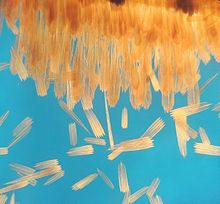
The wings, head, and parts of the thorax and abdomen of Lepidoptera are covered with minute scales, a feature from which the order derives its name. Most scales are
The lumen or surface of the lamella has a complex structure. It gives color either by colored pigments it contains, or through structural coloration with mechanisms that include photonic crystals and diffraction gratings.[31]
Scales function in insulation, thermoregulation, producing
Internal morphology
Reproductive system
In the
Digestive system
In the

Circulatory system
In the circulatory system, hemolymph, or insect blood, is used to circulate heat in a form of thermoregulation, where muscles contraction produces heat, which is transferred to the rest of the body when conditions are unfavorable.[36] In lepidopteran species, hemolymph is circulated through the veins in the wings by some form of pulsating organ, either by the heart or by the intake of air into the
Respiratory system
Air is taken in through spiracles along the sides of the abdomen and thorax supplying the trachea with oxygen as it goes through the lepidopteran's respiratory system. Three different tracheaes supply and diffuse oxygen throughout the species' bodies. The dorsal tracheae supply oxygen to the dorsal musculature and vessels, while the ventral tracheae supply the ventral musculature and nerve cord, and the visceral tracheae supply the guts, fat bodies, and gonads.[34]: 71, 72
Polymorphism

Polymorphism is the appearance of forms or "morphs", which differ in color and number of attributes within a single species.[15]: 163 [37] In Lepidoptera, polymorphism can be seen not only between individuals in a population, but also between the sexes as sexual dimorphism, between geographically separated populations in geographical polymorphism, and between generations flying at different seasons of the year (seasonal polymorphism or polyphenism). In some species, the polymorphism is limited to one sex, typically the female. This often includes the phenomenon of mimicry when mimetic morphs fly alongside nonmimetic morphs in a population of a particular species. Polymorphism occurs both at specific level with heritable variation in the overall morphological adaptations of individuals, as well as in certain specific morphological or physiological traits within a species.[15]
Environmental polymorphism, in which
Geographical isolation causes a divergence of a species into different morphs. A good example is the Indian white admiral
Sexual dimorphism is the occurrence of differences between males and females in a species. In Lepidoptera, it is widespread and almost completely set by genetic determination.
Reproduction and development
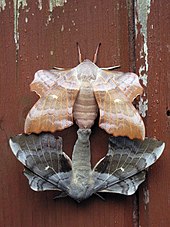
Species of Lepidoptera undergo
Lepidopterans in diapause
Unless the species reproduces year-round, a butterfly or moth may enter diapause, a state of dormancy that allows the insect to survive unfavorable environmental conditions.
Mating
Males usually start
Adaptations include undergoing one seasonal generation, two or even more, called voltinism (Univoltism, bivoltism, and multivism, respectively). Most lepidopterans in temperate climates are univoltine, while in tropical climates most have two seasonal broods. Some others may take advantage of any opportunity they can get, and mate continuously throughout the year. These seasonal adaptations are controlled by hormones, and these delays in reproduction are called diapause.[26]: 567 Many lepidopteran species, after mating and laying their eggs, die shortly afterwards, having only lived for a few days after eclosion. Others may still be active for several weeks and then overwinter and become sexually active again when the weather becomes more favorable, or diapause. The sperm of the male that mated most recently with the female is most likely to have fertilized the eggs, but the sperm from a prior mating may still prevail.[26]: 564
Life cycle
Eggs
Lepidoptera usually reproduce sexually and are oviparous (egg-laying), though some species exhibit live birth in a process called ovoviviparity. A variety of differences in egg-laying and the number of eggs laid occur. Some species simply drop their eggs in flight (these species normally have polyphagous larvae, meaning they eat a variety of plants e. g., hepialids and some nymphalids)[44] while most lay their eggs near or on the host plant on which the larvae feed. The number of eggs laid may vary from only a few to several thousand.[15] The females of both butterflies and moths select the host plant instinctively, and primarily, by chemical cues.[26]: 564
The eggs are derived from materials ingested as a larva and in some species, from the spermatophores received from males during mating.[45] An egg can only be 1/1000 the mass of the female, yet she may lay up to her own mass in eggs. Females lay smaller eggs as they age. Larger females lay larger eggs.[46] The egg is covered by a hard-ridged protective outer layer of shell, called the chorion. It is lined with a thin coating of wax, which prevents the egg from drying out. Each egg contains a number of micropyles, or tiny funnel-shaped openings at one end, the purpose of which is to allow sperm to enter and fertilize the egg. Butterfly and moth eggs vary greatly in size between species, but they are all either spherical or ovate.
The egg stage lasts a few weeks in most butterflies, but eggs laid prior to winter, especially in
Larvae

The larvae or caterpillars are the first stage in the life cycle after hatching. Caterpillars are "characteristic polypod larvae with cylindrical bodies, short thoracic legs, and abdominal prolegs (pseudopods)".[47] They have a sclerotized head capsule with an adfrontal suture formed by medial fusion of the sclerites, mandibles (mouthparts) for chewing, and a soft tubular, segmented body, that may have hair-like or other projections, three pairs of true legs, and additional prolegs (up to five pairs).[48] The body consists of thirteen segments, of which three are thoracic and ten are abdominal.[49] Most larvae are herbivores, but a few are carnivores (some eat ants or other caterpillars) and detritivores.[48]
Different herbivorous species have adapted to feed on every part of the plant and are normally considered pests to their host plants; some species have been found to lay their eggs on the fruit and other species lay their eggs on clothing or fur (e. g.,
The larvae develop rapidly with several generations in a year; however, some species may take up to 3 years to develop, and exceptional examples like Gynaephora groenlandica take as long as seven years.[15] The larval stage is where the feeding and growing stages occur, and the larvae periodically undergo hormone-induced ecdysis, developing further with each instar, until they undergo the final larval-pupal molt.
The larvae of both butterflies and moths exhibit mimicry to deter potential predators. Some caterpillars have the ability to inflate parts of their heads to appear snake-like. Many have false eye-spots to enhance this effect. Some caterpillars have special structures called
Wing development
No form of wing is externally visible on the larva, but when larvae are dissected, developing wings can be seen as disks, which can be found on the second and third thoracic segments, in place of the spiracles that are apparent on abdominal segments. Wing disks develop in association with a trachea that runs along the base of the wing, and are surrounded by a thin peripodial membrane, which is linked to the outer epidermis of the larva by a tiny duct. Wing disks are very small until the last larval instar, when they increase dramatically in size, are invaded by branching
Near pupation, the wings are forced outside the epidermis under pressure from the hemolymph, and although they are initially quite flexible and fragile, by the time the pupa breaks free of the larval cuticle, they have adhered tightly to the outer cuticle of the pupa (in obtect pupae). Within hours, the wings form a cuticle so hard and well-joined to the body that pupae can be picked up and handled without damage to the wings.[54]
Pupa
After about five to seven instars,[55]: 26–28 or molts, certain hormones, like PTTH, stimulate the production of ecdysone, which initiates insect molting. The larva starts to develop into the pupa: body parts specific to the larva, such as the abdominal prolegs, degenerate, while others such as the legs and wings undergo growth. After finding a suitable place, the animal sheds its last larval cuticle, revealing the pupal cuticle underneath.
Depending on the species, the pupa may be covered in a silk cocoon, attached to different types of substrates, buried in the ground, or may not be covered at all. Features of the imago are externally recognizable in the pupa. All the appendages on the adult head and thorax are found cased inside the cuticle (antennae, mouthparts, etc.), with the wings wrapped around, adjacent to the antennae.[26]: 564 The pupae of some species have functional mandibles, while the pupal mandibles are not functional in others.[25]
Although the pupal cuticle is highly sclerotized, some of the lower abdominal segments are not fused, and are able to move using small muscles found in between the membrane. Moving may help the pupa, for example, escape the sun, which would otherwise kill it. The pupa of the Mexican jumping bean moth (Cydia saltitans) does this. The larvae cut a trapdoor in the bean (species of Sebastiania) and use the bean as a shelter. With a sudden rise in temperature, the pupa inside twitches and jerks, pulling on the threads inside. Wiggling may also help to deter parasitoid wasps from laying eggs on the pupa. Other species of moths are able to make clicks to deter predators.[26]: 564, 566
The length of time before the pupa ecloses (emerges) varies greatly. The monarch butterfly may stay in its chrysalis for two weeks, while other species may need to stay for more than 10 months in diapause. The adult emerges from the pupa either by using abdominal hooks or from projections located on the head. The mandibles found in the most primitive moth families are used to escape from their cocoon (e. g.,
: 564Adult
Most lepidopteran species do not live long after eclosion, only needing a few days to find a mate and then lay their eggs. Others may remain active for a longer period (from one to several weeks) or go through diapause and overwintering as monarch butterflies do, or waiting out environmental stress. Some adult species of microlepidoptera go through a stage where no reproductive-related activity occurs, lasting through summer and winter, followed by mating and oviposition in the early spring.[26]: 564
While most butterflies and moths are
: 22Video gallery of butterfly life cycle (Pieris rapae, the common cabbage white)
-
Emerging from egg and first feedings.
-
Second instar larvae eating. Speeded up 50 times to illustrate feeding behavior. Nearly transparent body shows internal digestion.
-
This second instar larvae sheds skin in under 20 minutes.
-
Larvae eating remainder of a leaf. Six hours speeded up one hundred times.
-
Segments of the last two hours of the larvae shedding its 4th instar skin, after starting a few hours earlier.
-
Fifth instar white cabbage larvae walking on broccoli stem and on glass, showing it laying down silk it then walks on.
-
Parasitized larvae showing wasp larvae exiting its body, spinning cocoons. Playback at double speed. Adult wasps at normal speed.
-
Larvae shedding skin, becoming a chrysalis. Recorded over fifteen hours. Closeups at two times speed. Other clips at ten times speed.
-
Emerging from chrysalis into an adult.
-
Butterflies flying. Later clips in slow motion.
-
Male butterflies mud-puddling to concentrate salts for female reproduction.
-
Butterflies depositing eggs under leaves. Each repeated in slow motion.
Behavior
Flight
Flight is an important aspect of the lives of butterflies and moths, and is used for evading predators, searching for food, and finding mates in a timely manner, as most lepidopteran species do not live long after eclosion. It is the main form of locomotion in most species. In Lepidoptera, the forewings and hindwings are mechanically coupled and flap in synchrony. Flight is anteromotoric, or being driven primarily by action of the forewings. Although lepidopteran species reportedly can still fly when their hindwings are cut off, it reduces their linear flight and turning capabilities.[57]
Lepidopteran species have to be warm, about 77 to 79 °F (25 to 26 °C), to fly. They depend on their body temperature being sufficiently high and since they cannot regulate it themselves, this is dependent on their environment. Butterflies living in cooler climates may use their wings to warm their bodies. They will bask in the sun, spreading out their wings so that they get maximum exposure to the sunlight. In hotter climates butterflies can easily overheat, so they are usually active only during the cooler parts of the day, early morning, late afternoon or early evening. During the heat of the day, they rest in the shade. Some larger thick-bodied moths (e.g. Sphingidae) can generate their own heat to a limited degree by vibrating their wings. The heat generated by the flight muscles warms the thorax while the temperature of the abdomen is unimportant for flight. To avoid overheating, some moths rely on hairy scales, internal air sacs, and other structures to separate the thorax and abdomen and keep the abdomen cooler.[citation needed]
Some species of butterflies can reach fast speeds, such as the southern dart, which can go as fast as 48.4 kilometres per hour (30.1 mph). Sphingids are some of the fastest flying insects, some are capable of flying at over 50 kilometres per hour (31 mph), having a wingspan of 35–150 millimetres (1.4–5.9 in).[3][58] In some species, sometimes a gliding component to their flight exists. Flight occurs either as hovering, or as forward or backward motion.[59] In butterfly and moth species, such as hawk moths, hovering is important as they need to maintain a certain stability over flowers when feeding on the nectar.[3]

Many studies have also shown that moths navigate. One study showed that many moths may use the Earth's magnetic field to navigate, as a study of the heart and dart moth suggests.[64] Another study, of the migratory behavior of the silver Y, showed, even at high altitudes, the species can correct its course with changing winds, and prefers flying with favourable winds, suggesting a great sense of direction.[65][66] Aphrissa statira in Panama loses its navigational capacity when exposed to a magnetic field, suggesting it uses the Earth's magnetic field.[67]
Moths exhibit a tendency to circle artificial lights repeatedly. This suggests they use a technique of
Migration
Lepidopteran migration is typically
Moths also undertake migrations, an example being the
Communication
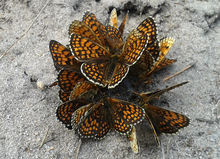
Pheromones are commonly involved in mating rituals among species, especially moths, but they are also an important aspect of other forms of communication. Usually, the pheromones are produced by either the male or the female and detected by members of the opposite sex with their antennae.[75] In many species, a gland between the eighth and ninth segments under the abdomen in the female produces the pheromones.[15] Communication can also occur through stridulation, or producing sounds by rubbing various parts of the body together.[66]
Moths are known to engage in acoustic forms of communication, most often as courtship, attracting mates using sound or vibration. Like most other insects, moths pick up these sounds using tympanic membranes in their abdomens.[76] An example is that of the polka-dot wasp moth (Syntomeida epilais), which produces sounds with a frequency above that normally detectable by humans (about 20 kHz). These sounds also function as tactile communication, or communication through touch, as they stridulate, or vibrate a substrate like leaves and stems.[43]
Most moths lack bright colors, as many species use coloration as
Ecology
Moths and butterflies are important in the natural ecosystem. They are integral participants in the food chain; having co-evolved with flowering plants and predators, lepidopteran species have formed a network of trophic relationships between autotrophs and heterotrophs, which are included in the stages of Lepidoptera larvae, pupae, and adults. Larvae and pupae are links in the diets of birds and parasitic entomophagous insects. The adults are included in food webs in a much broader range of consumers (including birds, small mammals, reptiles, etc.).[26]: 567
Defense and predation

Lepidopteran species are soft bodied, fragile, and almost defenseless, while the immature stages move slowly or are immobile, hence all stages are exposed to
An "
Some species of Lepidoptera are poisonous to predators, such as the monarch butterfly in the Americas,
Camouflage is also an important defense strategy, which involves the use of coloration or shape to blend into the surrounding environment. Some lepidopteran species blend with their surroundings, making them difficult to spot by predators. Caterpillars can exhibit shades of green that match its host plant. Caterpillars have been demonstrated to be able to detect the color of their surroundings and substrate using organs on their feet.[83] Some caterpillars look like inedible objects, such as twigs or leaves. For instance, the mourning cloak fades into the backdrop of trees when it folds its wings back. The larvae of some species, such as the common Mormon (Papilio polytes) and the western tiger swallowtail look like bird droppings.[78][84] For example, adult Sesiidae species (also known as clearwing moths) have a general appearance sufficiently similar to a wasp or hornet to make it likely the moths gain a reduction in predation by Batesian mimicry.[85] Eyespots are a type of automimicry used by some butterflies and moths. In butterflies, the spots are composed of concentric rings of scales in different colors. The proposed role of the eyespots is to deflect attention of predators. Their resemblance to eyes provokes the predator's instinct to attack these wing patterns.[86]
Moths are able to hear the range emitted by bats, which in effect causes flying moths to make evasive maneuvers because bats are a main predator of moths. Ultrasonic frequencies trigger a reflex action in the
Pollination

Most species of Lepidoptera engage in some form of entomophily (more specifically psychophily and phalaenophily for butterflies and moths, respectively), or the pollination of flowers.[91] Most adult butterflies and moths feed on the nectar inside flowers, using their probosces to reach the nectar hidden at the base of the petals. In the process, the adults brush against the flowers' stamens, on which the reproductive pollen is made and stored. The pollen is transferred on appendages on the adults, which fly to the next flower to feed and unwittingly deposit the pollen on the stigma of the next flower, where the pollen germinates and fertilizes the seeds.[26]: 813–814
Flowers pollinated by butterflies tend to be large and flamboyant, pink or lavender in color, frequently having a landing area, and usually scented, as butterflies are typically day-flying. Since butterflies do not digest pollen (except for heliconid species,[91]) more nectar is offered than pollen. The flowers have simple nectar guides, with the nectaries usually hidden in narrow tubes or spurs, reached by the long "tongue" of the butterflies. Butterflies such as Thymelicus flavus have been observed to engage in flower constancy, which means they are more likely to transfer pollen to other conspecific plants. This can be beneficial for the plants being pollinated, as flower constancy prevents the loss of pollen during different flights and the pollinators from clogging stigmas with pollen of other flower species.[92]
Among the more important moth pollinator groups are the
Mutualism

Mutualism is a form of biological interaction wherein each individual involved benefits in some way. An example of a mutualistic relationship would be that shared by yucca moths (Tegeculidae) and their host, yucca flowers (Asparagaceae). Female yucca moths enter the host flowers, collect the pollen into a ball using specialized maxillary palps, then move to the apex of the pistil, where pollen is deposited on the stigma, and lay eggs into the base of the pistil where seeds will develop. The larvae develop in the fruit pod and feed on a portion of the seeds. Thus, both insect and plant benefit, forming a highly mutualistic relationship.[26]: 814 Another form of mutualism occurs between some larvae of butterflies and certain species of ants (e.g. Lycaenidae). The larvae communicate with the ants using vibrations transmitted through a substrate, such as the wood of a tree or stems, as well as using chemical signals.[95] The ants provide some degree of protection to these larvae and they in turn gather honeydew secretions.[96]
Parasitism

Only 42 species of

In reverse, moths and butterflies may be subject to
In response to a parasitoid egg or larva in the caterpillar's body, the
Other biological interactions
A few species of Lepidoptera are secondary consumers, or predators. These species typically prey upon the eggs of other insects, aphids, scale insects, or ant larvae.[26]: 567 Some caterpillars are cannibals, and others prey on caterpillars of other species (e.g. Hawaiian Eupithecia ). Those of the 15 species in Eupithecia that mirror inchworms, are the only known species of butterflies and moths that are ambush predators.[99] Four species are known to eat snails. For example, the Hawaiian caterpillar (Hyposmocoma molluscivora) uses silk traps, in a manner similar to that of spiders, to capture certain species of snails (typically Tornatellides).[98]
Larvae of some species of moths in the
In 2015 it was reported that wasp bracovirus DNA was present in Lepidoptera such as monarch butterflies, silkworms and moths.[101] These were described in some newspaper articles as examples of a naturally occurring genetically engineered insects.[102]
Evolution and systematics
History of study

Linnaeus in
Among the first entomologists to study fossil insects and their evolution was
Major contributions in the 20th century included the creation of the monotrysia and ditrysia (based on female genital structure) by Borner in 1925 and 1939.
Many attempts have been made to group the superfamilies of the Lepidoptera into natural groups, most of which fail because one of the two groups is not monophyletic: Microlepidoptera and Macrolepidoptera, Heterocera and Rhopalocera, Jugatae and Frenatae, Monotrysia and Ditrysia.[103]
A 2024 genetic study found that the genomes of butterflies and moths have remained largely unchanged over the past 250 million years.[105]
Fossil record

The fossil record for Lepidoptera is lacking in comparison to other winged species and tends not to be as common as some other insects in habitats that are most conducive to fossilization, such as lakes and ponds; their juvenile stage has only the head capsule as a hard part that might be preserved. Also, the scales covering their wings are hydrophobic and prevents their body from sinking when they end up on the water's surface.[106] Lepidopteran bodies tend to come apart after death, and decompose quickly, so fossil remains are often extremely fragmentary. Of the fossils known, only an estimated 7% have been described.[107] The location and abundance of the most common moth species are indicative that mass migrations of moths occurred over the Palaeogene North Sea, which is why there is a serious lack of moth fossils.[108] Yet there are fossils, some preserved in amber and some in very fine sediments. Leaf mines are also seen in fossil leaves, although the interpretation of them is tricky.[104]
Putative fossil stem group representatives of Amphiesmenoptera (the clade comprising Trichoptera and Lepidoptera) are known from the Triassic.[26]: 567 The earliest known lepidopteran fossils are fossilized scales from the Triassic-Jurassic boundary. They were found as rare palynological elements in the sediments of the Triassic-Jurassic boundary from the cored Schandelah-1 well, drilled near Braunschweig in northern Germany. This pushes back the fossil record and origin of glossatan lepidopterans by about 70 million years, supporting molecular estimates of a Norian (ca 212 million years) divergence of glossatan and non-glossatan lepidopterans. The findings were reported in 2018 in the journal Science Advances. The authors of the study proposed that lepidopterans evolved a proboscis as an adaptation to drink from droplets and thin films of water for maintaining their fluid balance in the hot and arid climate of the Triassic.[109]
The earliest named lepidopteran taxon is
Many more fossils are found from the Tertiary, and particularly the
Phylogeny
Lepidoptera and
The
| part of Holometabola |
| ||||||||||||||||||||||||
The Eriocraniidae have a short coiled proboscis in the adult stage, and though they retain their pupal mandibles with which they escaped the cocoon, their mandibles are non-functional thereafter.[103] Most of these non-ditrysian families, are primarily leaf miners in the larval stage. In addition to the proboscis, there is a change in the scales among these basal lineages, with later lineages showing more complex perforated scales.[104]
With the evolution of the Ditrysia in the mid-Cretaceous, there was a major reproductive change. The Ditrysia, which comprise 98% of the Lepidoptera, have two separate openings for reproduction in the females (as well as a third opening for excretion), one for mating, and one for laying eggs. The two are linked internally by a seminal duct. (In more basal lineages there is one cloaca, or later, two openings and an external sperm canal.) Of the early lineages of Ditrysia, Gracillarioidea and Gelechioidea are mostly leaf miners, but more recent lineages feed externally. In the Tineoidea, most species feed on plant and animal detritus and fungi, and build shelters in the larval stage.[104]
The Yponomeutoidea is the first group to have significant numbers of species whose larvae feed on herbaceous plants, as opposed to woody plants.[104] They evolved about the time that flowering plants underwent an expansive adaptive radiation in the mid-Cretaceous, and the Gelechioidea that evolved at this time also have great diversity. Whether the processes involved coevolution or sequential evolution, the diversity of the Lepidoptera and the angiosperms increased together.
In the so-called "macrolepidoptera", which constitutes about 60% of lepidopteran species, there was a general increase in size, better flying ability (via changes in wing shape and linkage of the forewings and hindwings), reduction in the adult mandibles, and a change in the arrangement of the crochets (hooks) on the larval prolegs, perhaps to improve the grip on the host plant.[104] Many also have tympanal organs, that allow them to hear. These organs evolved eight times, at least, because they occur on different body parts and have structural differences.[104] The main lineages in the macrolepidoptera are the
Taxonomy
Taxonomy is the classification of species in selected taxa, the process of naming being called
- Micropteryx in the Palearctic region. There are only two known in North America (Epimartyria), with many more being found in Asia and the southwest Pacific, particularly New Zealand with about 50 species.[26]: 569
- Agathiphagidae is the only family in Aglossata and contains two species in its only genus, Agathiphaga.[26]: 569 [118] Agathiphaga queenslandensis and Agathiphaga vitiensis are found along the north-eastern coast of Queensland, Australia, and in Fiji to Vanuatu and the Solomon Islands, respectively.[119][120]
- Heterobathmiidae is the only family and includes about 10 species, which are day-flying, metallic moths, confined to southern South America, the adults eat the pollen of Nothofagus or southern beech and the larvae mine the leaves.[26]: 569 [121]
- basal clades still retaining some of the ancestral features of the wings such as similarly shaped fore- and hindwings with relatively complete venation. Glossata also contains the division Ditrysia, which contains 98% of all described species in Lepidoptera.[26]: 569
Relationship to people
Culture
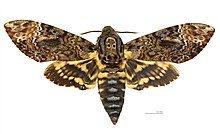
Artistic depictions of butterflies have been used in many cultures including as early as 3500 years ago, in Egyptian hieroglyphs.[122] Today, butterflies are widely used in various objects of art and jewelry: mounted in frames, embedded in resin, displayed in bottles, laminated in paper, and in some mixed media artworks and furnishings.[123] Butterflies have also inspired the "butterfly fairy" as an art and fictional character.
In many cultures the soul of a dead person is associated with the butterfly, for example in
In the ancient
Pests
The
Butterflies and moths are one of the largest taxa to solely feed and be dependent on living plants, in terms of the number of species, and they are in many ecosystems, making up the largest biomass to do so. In many species, the female may produce anywhere from 200 to 600 eggs, while in some others it may go as high as 30,000 eggs in one day. This can create many problems for agriculture, where many caterpillars can affect acres of vegetation. Some reports estimate that there have been over 80,000 caterpillars of several different taxa feeding on a single oak tree. In some cases, phytophagous larvae can lead to the destruction of entire trees in relatively short periods of time.[26]: 567
Ecological ways of removing pest Lepidoptera species are becoming more economically viable, as research has shown ways like introducing parasitic wasps and flies. For example, Sarcophaga aldrichi, a fly which deposited larvae feed upon the pupae of the forest tent caterpillar moth. Pesticides can affect other species other than the species they are targeted to eliminate, damaging the natural ecosystem.[129] Another good biological pest control method is the use of pheromone traps. A pheromone trap is a type of insect trap that uses pheromones to lure insects. Sex pheromones and aggregating pheromones are the most common types used. A pheromone-impregnated lure is encased in a conventional trap such as a Delta trap, water-pan trap, or funnel trap.[130]
Species of moths that are
Beneficial insects
Even though some butterflies and moths affect the economy negatively, many species are a valuable economic resource. The most prominent example is that of the domesticated silkworm moth (Bombyx mori), the larvae of which make their cocoons out of silk, which can be spun into cloth. Silk is and has been an important economic resource throughout history. The species Bombyx mori has been domesticated to the point where it is completely dependent on mankind for survival.[131] A number of wild moths such as Bombyx mandarina, and Antheraea species, besides others, provide commercially important silks.[132]
The preference of the larvae of most lepidopteran species to feed on a single species or limited range of plants is used as a mechanism for biological control of
Breeding butterflies and moths, or butterfly gardening/rearing, has become an ecologically viable process of introducing species into the ecosystem to benefit it. Butterfly ranching in Papua New Guinea permits nationals of that country to "farm" economically valuable insect species for the collectors market in an ecologically sustainable manner.[134]
Food
Lepidoptera feature prominently in
Health
Some larvae of both moths and butterflies have a form of hair that has been known to be a cause of human health problems. Caterpillar hairs sometimes have toxins in them and species from approximately 12 families of moths or butterflies worldwide can inflict serious human injuries (
These hairs have also been known to cause keratoconjunctivitis. The sharp barbs on the end of caterpillar hairs can get lodged in soft tissues and mucous membranes such as the eyes. Once they enter such tissues, they can be difficult to extract, often exacerbating the problem as they migrate across the membrane.[142] This becomes a particular problem in an indoor setting. The hairs easily enter buildings through ventilation systems and accumulate in indoor environments because of their small size, which makes it difficult for them to be vented out. This accumulation increases the risk of human contact in indoor environments.[143]
See also
- Comparison of butterflies and moths
- Lepidoptera in the 10th edition of Systema Naturae
- McGuire Center for Lepidoptera and Biodiversity, University of Florida
- Societas Europaea Lepidopterologica
Lists
References
- ^ a b c Mallet, Jim (12 June 2007). "Taxonomy of Lepidoptera: the scale of the problem". The Lepidoptera Taxome Project. University College, London. Archived from the original on 5 June 2011. Retrieved 8 February 2011.
- ^ "Lepidoptera Taxome Project". Lepidoptera Taxome Project. Archived from the original on 5 August 2011. Retrieved 25 February 2015.
- ^ ISBN 9781402062421. Archivedfrom the original on 24 June 2016. Retrieved 22 September 2016.
- ^ ISBN 978-0-12-374144-8.
- ^ ISBN 978-0-12-690647-9. Archived from the original(PDF) on 15 May 2013. Retrieved 2 March 2010.
- ^ Linnaeus, Carl (1746). Fauna Svecica: sistens animalia Sveciæ regni: qvadrupedia, aves, amphibia, pisces, insecta, vermes, distributa per classes & ordines, genera & species. Cum differentiis specierum, synonymis autorum, nominibus incolarum, locis habitationum, descriptionibus insectorum (in Latin). Lugduni Batavorum [Leiden]: C. Wishoff et G.J. Wishoff. p. 232. Archived from the original on 18 September 2020. Retrieved 8 August 2020.
- PMID 23317047.
- ^ Harper, Douglas. "lepidoptera". Online Etymology Dictionary.
- Perseus Project.
- ^ ISBN 978-0-203-42114-7.
- ^ Harpe, Douglas; Dan McCormack (November 2001). "Online Etymological Dictionary". LogoBee. p. 1. Archived from the original on 25 August 2012. Retrieved 6 December 2009.
- ISBN 978-0-8493-0212-1. Archivedfrom the original on 31 May 2021. Retrieved 8 October 2020.
- ^ Harper, Douglas. "moth". The Online Etymology Dictionary. Archived from the original on 6 June 2011. Retrieved 31 March 2011.
- ^ "Caterpillar". Dictionary.com. Archived from the original on 9 September 2011. Retrieved 5 October 2011.
- ^ ISBN 978-1-4051-1113-3.
- ^ Stumpe, Felix. "Parnassius arctica Eisner, 1968". Russian-Insects.com. Archived from the original on 15 July 2011. Retrieved 9 November 2010.
- ISBN 978-90-6193-114-0. Archivedfrom the original on 19 July 2021. Retrieved 9 November 2010.
- ^ Sherman, Lee (2008). "An OSU scientist braves an uncharted rainforest in a search for rare and endangered species" (PDF). Terra. 3 (2). Oregon State University. Archived from the original (PDF) on 19 September 2011. Retrieved 14 February 2011.
- ^ .
- ^ Mallet, Jim (12 June 2007). "Taxonomy of butterflies: the scale of the problem". The Lepidoptera Taxome Project. University College, London. Archived from the original on 14 May 2011. Retrieved 8 February 2011.
- ISBN 978-0-618-15310-7. Archivedfrom the original on 24 July 2019. Retrieved 22 September 2016.
- ISBN 978-0-8014-3130-2. Retrieved 12 February 2011.
- ISBN 978-0-7301-0461-2.
- ^ ISBN 978-0-306-44967-3. Archivedfrom the original on 10 March 2017. Retrieved 14 November 2010.
- ^ a b c d Scoble (1995). Section The Adult Head – Feeding and Sensation, (pp. 4–22).
- ^ ISBN 978-0-12-374144-8.
- ISBN 978-1-55297-612-8.
- ISBN 978-1-4020-6242-1. Archivedfrom the original on 24 June 2016. Retrieved 22 September 2016.
- ISBN 978-1-4020-6242-1.
- ^ a b Scoble (1995). Section Scales, (pp. 63–66).
- S2CID 52828850.
- .
- PMID 20268135.
- ^ ISBN 978-1-4443-3036-6. Archivedfrom the original on 1 June 2021. Retrieved 8 October 2020.
- ISBN 978-0801431302, retrieved 30 July 2018.
- .
- S2CID 202575235.
- ^ ISBN 9781405111133.
- PMID 18769543.
- ^ ISBN 978-81-7371-354-5.
- ^ Ivy I. G., Morgun D. V., Dovgailo K. E., Rubin N. I., Solodovnikov I. A. Дневные бабочки (Hesperioidea and Papilionoidea, Lepidoptera) Восточной Европы. " CD determinant, database and software package "Lysandra". Minsk, Kiev, Moscow: 2005. In Russian
- ^ "Psychidae at Bug Guide". Iowa State University. Archived from the original on 10 February 2012. Retrieved 19 January 2010.
- ^ S2CID 1359112.
- S2CID 29210301.
- ISBN 978-0801441882.
- ^ Oberhauser 2004, p. 24.
- ISBN 978-1-4443-3036-6.
- ^ ]
- ISBN 978-0-03-096835-8.
- S2CID 86427983.
- ISBN 978-0-8493-0212-1. Archivedfrom the original on 31 May 2021. Retrieved 8 October 2020.
- JSTOR 3223096.
- JSTOR 2406212.
- ^ ISBN 978-0-87474-917-5. Archivedfrom the original on 31 May 2021. Retrieved 8 October 2020.
- ^ ISBN 978-1-889538-58-7.
metamorphosis butterfly.
- ISBN 978-0-471-55007-5.
- PMID 18936482.
- ^ Reisner, Alex. "Speed of animals". speedofanimals.com. Archived from the original on 25 February 2011. Retrieved 20 February 2011.
- ISBN 978-0-19-854952-9. Archivedfrom the original on 1 June 2021. Retrieved 11 September 2020.
- S2CID 17755509.
- S2CID 84711127.
- S2CID 20605146.
- ISBN 978-90-6590-303-7.
- S2CID 54314728.
- ^ Breen, Amanda (7 May 2008). "Scientists make compass discovery in migrating moths". University of Greenwich at Medway. p. 1. Archived from the original on 30 May 2012. Retrieved 9 December 2009.
- ^ (PDF) from the original on 31 May 2021. Retrieved 11 September 2020.
- S2CID 25203050. Archived from the original(PDF) on 4 November 2009.
- ^ Elliot, Debbie; Berenbaum, May (18 August 2007). "Why are Moths Attracted to Flame? (audio)". National Public Radio. p. 1. Archived from the original on 8 January 2009. Retrieved 12 December 2009.
- ISBN 978-0-911302-21-9.
- PMID 27147998.
- .
- S2CID 86198255.
- PMID 9860986.
- ^ Smith, N. G. (1983). Janzen, D. H. (ed.). Urania fulgens (Calipato Verde, Green Urania). Costa Rican Natural History. Chicago: University of Chicago Press. p. 816.
- ISBN 978-0-521-57890-5.
Insects.
- ^ a b Meyer, John R. (2006). "Acoustic Communication". Department of Entomology, C State University. Archived from the original on 20 July 2011. Retrieved 25 February 2011.
- JSTOR 3881502.
- ^ a b c d "Caterpillar and Butterfly Defense Mechanisms". EnchantedLearning.com. Archived from the original on 28 March 2009. Retrieved 7 December 2009.
- ISBN 978-0-691-00974-2. Archivedfrom the original on 31 May 2021. Retrieved 8 October 2020.
- PMID 14555763. (Abstract).
- ^ "osmeterium". Merriam-Webster, Incorporated. Archived from the original on 20 February 2010. Retrieved 9 December 2009.
- ^ Hadley, Debbie. "Osmeterium". About.com Guide. Archived from the original on 23 July 2008. Retrieved 9 December 2009.
- PMID 31396566.
- ISBN 978-0-395-97944-0.
Tiger swallowtail.
- ISBN 978-0-7614-7344-2. Archivedfrom the original on 31 May 2021. Retrieved 8 October 2020.
- ISBN 978-0-393-06016-4.
Butterfly eyespots defense.
- S2CID 28667520.
Viceroys are as unpalatable as monarchs, and significantly more unpalatable than queens from representative Florida populations.
- PMID 17048984.
- PMID 11467425.
- PMID 19324625. Archived from the original(PDF) on 19 July 2011. Retrieved 11 February 2011.
- ^ PMID 16591992.
- S2CID 620334.
- PMID 21665724.
- S2CID 21936259.
- .
- S2CID 35812411.
- ^ Benton, Frank (1895). The honey bee: a manual of instruction in apiculture [Europe's best known butterflies. Description of the most important species and instructions for recognizing and collecting butterflies and caterpillars]. Vol. 1–6, 33. Oestergaard Verlag. pp. 113–114. Archived from the original on 31 May 2021. Retrieved 11 September 2020.
- ^ S2CID 42604851.
- ^ Pierce, N. E. (1995). "Predatory and parasitic Lepidoptera: Carnivores living on plants". Journal of the Lepidopterists' Society. 49 (4): 412–453.
- ^ a b Grabe, Albert (1942). Eigenartige Geschmacksrichtungen bei Kleinschmetterlingsraupen ("Strange tastes among micromoth caterpillars") (PDF). 27 (in German). pp. 105–109.
- PMID 26379286.
- ^ Shaikh-Lesko, Rina (17 September 2015). "Parasite's Genes Persist in Host Genomes | The Scientist Magazine®". The Scientist. Archived from the original on 21 December 2016. Retrieved 13 July 2016.
- ^ ISBN 978-0-19-854952-9. Archivedfrom the original on 26 June 2020. Retrieved 11 September 2020.
- ^ ISBN 978-0-521-82149-0.
- PMC 11009112.)
{{cite journal}}: CS1 maint: multiple names: authors list (link - ^ Illusion of flight? Absence, evidence and the age of winged insects
- ^ Sohn, JC., Labandeira, C.C. & Davis, D.R. The fossil record and taphonomy of butterflies and moths (Insecta, Lepidoptera): implications for evolutionary diversity and divergence-time estimates. Archived 7 March 2021 at the Wayback Machine BMC Evol Biol 15, 12 (2015). https://doi.org/10.1186/s12862-015-0290-8
- S2CID 4374137.
- PMID 29349295.
- ISBN 978-0-521-82149-0. Archivedfrom the original on 8 January 2014. Retrieved 15 July 2011.
- ISBN 978-0-8135-4268-3. Archivedfrom the original on 8 January 2014. Retrieved 15 July 2011.
- .
- PMID 21903172.
- S2CID 33808144.
- ^ Yeates, David K.; Wiegmann, Brian. "Endopterygota Insects with complete metamorphosis". Tree of Life. Archived from the original on 26 May 2016. Retrieved 24 May 2016.
- S2CID 56100681. Archived from the originalon 5 January 2013.
- ISBN 978-0-231-50170-5.
- Walter de Gruyter. pp. 41–49.
- ^ "Species Agathiphaga queenslandensis Dumbleton, 1952". Australian Faunal Directory. Department of the Environment, Water, Heritage and the Arts. 9 October 2008. Archived from the original on 5 April 2011. Retrieved 31 August 2010.
- ^ Beccaloni, G.; Scoble, M.; Kitching, I.; Simonsen, T.; Robinson, G.; Pitkin, B.; Hine, A.; Lyal, C., eds. (2003). "Agathiphaga vitiensis". The Global Lepidoptera Names Index. Natural History Museum. Retrieved 8 May 2018.
- ^ Beccaloni, G.; Scoble, M.; Kitching, I.; Simonsen, T.; Robinson, G.; Pitkin, B.; Hine, A.; Lyal, C., eds. (2003). "Heterobathmia". The Global Lepidoptera Names Index. Natural History Museum. Retrieved 8 May 2018.
- Saudi Aramco World. 45 (5): 24–27. Archived from the originalon 13 January 2010. Retrieved 18 December 2009.
- ^ "Table complete with real butterflies embedded in resin". Mfjoe.com. 18 December 2009. Archived from the original on 6 May 2010. Retrieved 28 April 2012.
- Cultural Entomology Digest 4. Cupertino, California: Bugbios. p. 4. Archived from the originalon 3 December 1998. Retrieved 18 December 2009.
- ISBN 978-0-486-21901-1.
- ISBN 978-0-500-27928-1.
- ^ Cook, Kelly A.; Weinzier, R. (2004). "IPM: Field Crops: Corn Earworm (Heliothis Zea)". IPM. p. 1. Archived from the original on 9 February 2009. Retrieved 17 January 2009.
- ISBN 9781402062421.
- ^ Hahn, Jeff (15 June 2003). "Friendly Flies: Good News, Bad News". Yard & Garden Line News. 5 (9). University of Minnesota. Archived from the original on 20 July 2011.
- ^ Weinzierl, R.; Henn, T.; Koehler, P. G.; Tucker, C. L. (June 2005). "Insect Attractants and Traps". Alternatives in Insect Management. Entomology and Nematology Department, University of Florida. Office of Agricultural Entomology, University of Illinois at Urbana-Champaign. Archived from the original on 11 March 2011.
- S2CID 44514698.
- ^ Yoshitake, N. (1968). "Phylogenetic aspects on the origin of Japanese race of the silkworm, Bombyx mori". Journal of Sericological Sciences of Japan. 37: 83–87.
- ISBN 978-0-87071-029-2.
- ^ Butterfly Farms | Rainforest Conservation | Butterfly Ranching Archived 22 January 2008 at the Wayback Machine. butterfliesandart.com
- ISBN 978-1-74104-558-1. (pg 63)
- S2CID 53963758.
- PMID 21211040.
- S2CID 73665731.
- PMID 15772333.
- PMID 17368636.
- PMID 17221019. Free full text.
- ^ Patel RJ, Shanbhag RM (1973). "Ophthalmia nodosa – (a case report)". Indian Journal of Ophthalmology. 21 (4): 208. Archived from the original on 12 September 2019. Retrieved 17 November 2018.
- from the original on 4 April 2011. Retrieved 25 February 2011.. Free full text.
Further reading
- Kristensen, N. P. (ed.) 1999. Lepidoptera, Moths and Butterflies. Volume 1: Evolution, Systematics, and Biogeography. Handbuch der Zoologie. Eine Naturgeschichte der Stämme des Tierreiches / Handbook of Zoology. A Natural History of the phyla of the Animal Kingdom. Band / Volume IV Arthropoda: Insecta Teilband / Part 35: 491 pp. Walter de Gruyter, Berlin, New York.
- Nemos, F. (c. 1895). Europas bekannteste Schmetterlinge. Beschreibung der wichtigsten Arten und Anleitung zur Kenntnis und zum Sammeln der Schmetterlinge und Raupen [Europe's best known butterflies. Description of the most important species and instructions for recognising and collecting butterflies and caterpillars] (PDF). Berlin: Oestergaard Verlag. Archived from the original (PDF) on 24 July 2011.
- Nye, I. W. B. & Fletcher, D. S. 1991. Generic Names of Moths of the World. Volume 6: xxix + 368 pp. Trustees of the British Museum (Natural History), London.
- O'Toole, Christopher. 2002. Firefly Encyclopedia of Insects and Spiders. ISBN 1-55297-612-2.
- Bibliography
- Lamas, Gerardo (1990). "An Annotated List of Lepidopterological Journals" (PDF). Journal of Research on the Lepidoptera. 29 (1–2): 92–104. S2CID 108756448. Archived from the original(PDF) on 27 August 2016. Retrieved 22 November 2012.
External links
- Natural History Museum archived database of host plants
- Historic Moth illustrations
- Lepidoptera at Insects (Insecta) of the World
- "Lepidoptera". Integrated Taxonomic Information System.
- Caught Between the Pages: Treasures from the Franclemont Collection Online virtual exhibit featuring a selection of historic entomological writings and images from the Comstock Library of Entomology at Cornell University
- Regional sites
- British Butterflies and Moths
- Butterflies of Bulgaria Archived 5 April 2008 at the Wayback Machine
- Butterflies of Canada
- Photography of European Butterflies and Moths
- Lepidoptera of French Antilles
- Butterflies of India
- A Check List of Butterflies in Indo-China
- Moths of Jamaica
- Japmoth Japanese moths. Access images via the numbers on the left.
- Butterflies and Moths in the Netherlands
- Butterflies and Moths of Northern Ireland Archived 1 August 2015 at the Wayback Machine
- Butterflies of Asian Russia Archived 31 August 2007 at the Wayback Machine
- Photos of Larvae and Pupae butterflies and moths. Spain Archived 28 July 2013 at the Wayback Machine
- Butterflies of Asturias – Spain
- Swedish Moths and Butterflies Lepidoptera (English)
- Butterflies of Turkey




